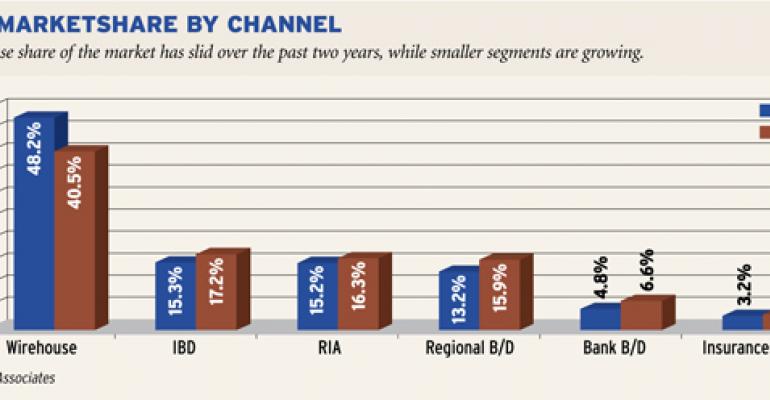Wirehouses, the 800-pound gorillas in the financial advisory world, are starting to look more like 700-pound gorillas — still heavyweights, but getting a little leaner.
New data from Cerulli Associates suggest 2009 was an especially tough year for the channel, with investors leaving, or just sitting on the sidelines, and advisors going independent and taking their clients' assets with them. “We were shocked by the degree to which they were hurt by the market crisis, especially relative to the rest of the advisory industry,” said Cerulli analyst Bing Waldert. “The fact that the firms essentially didn't participate in the upside of the market is pretty telling.”
Indeed, nearly every advisor channel except the wirehouses posted double-digit asset growth last year versus 2008: 27.4 percent at independent broker/dealers, 26.6 percent at RIAs, 18.5 percent overall. But wirehouse assets grew a mere 6.4 percent (The numbers reflect a combination of investment performance, the movement of assets from channel to channel by advisors switching jobs, and client investments and withdrawals.)
Of course, the wirehouses' share of the asset marketplace was still more than twice as large as anywhere else at 40.5 percent at year-end 2009, but that was down from 48.2 percent in 2007.
Meanwhile, advisor headcount is also declining in the wirehouse channel, and rising at the independents. In 2009, about 8.5 percent of wirehouse advisors departed the channel, bringing the year-end total to 50,204. Cerulli analyst Bing Waldert says part of that is the result of lower-producing advisors being forced out through attrition, because the vast majority of advisors who leave their wirehouse employers are still moving to other wirehouses. By comparison, advisor headcount at the IBDs was up a little under 1 percent, to 98,848, while RIAs saw a 5.9 percent increase, to 19,681.
Those who do leave the wirehouses cite a number of reasons for making that choice. In a survey of advisors who left wirehouse firms conducted in 2009 by Aite Group, the desire to move to a different advice model was the biggest reason (32 percent). Uncertainty about the direction their previous employer was heading took second place, at 23 percent. A desire for a higher payout and a view that their previous employer's brand was severely damaged in the credit crisis tied for third place among rationales for leaving, with 18 percent apiece.
The sluggish stock market, shaken by the May “flash crash,” the sovereign debt crisis in Europe, and sustained high unemployment in the United States, hasn't helped. One Merrill Lynch broker complains that commissions are depressed across the country. “The summer has been very, very slow for most people. I'm talking senior level guys, brokers who have been in the business for 40 years, and they've never seen an August this slow,” he says. But brokers who remain in the channel continue to believe that the deep pockets of the wirehouses and the depth of their resources will serve them and their clients well.
Ronald C. Hart, who leads the Hart Group at Morgan Stanley Smith Barney in Atlanta (see profile on page 41) says the resources of a large firm give him more flexibility. He counts business owners among his clients. “I'd love to have 95 percent payout. I'd love that,” Hart says. “But if I want to take a client public, if the client has a company he wants to sell, it's nice to have the best bankers. It's nice to have capital markets. It's nice to have some research.”
Waldert is forecasting continued market share losses for the wirehouses, but he agrees that the channel's strength will serve it well in the future. “These are the best capitalized participants in the wealth management industry. They can throw more capital at this business than anybody else,” he says. “It's not going to be bad for them forever. They've got too much in terms of resources to be down for too long.”
See below for this year's top 100 list and profiles:
Top 100 Wirehouse Advisors in America, 2010
Matthew L. Dermer and Jesse M. Eaton
John Jeff Erdmann III
Ronald C. Hart
Emily W. Van Hoorickx






